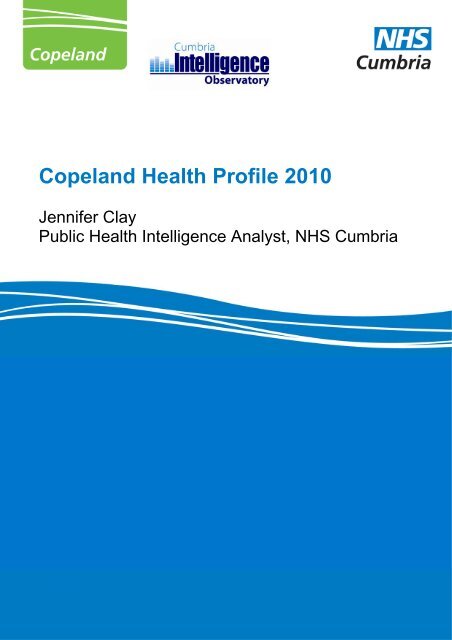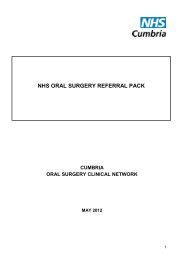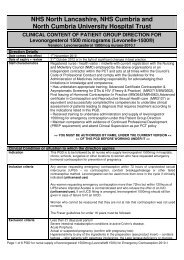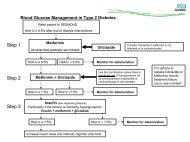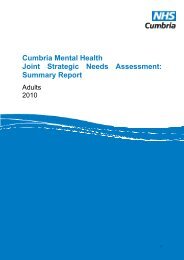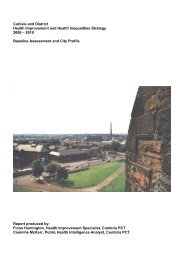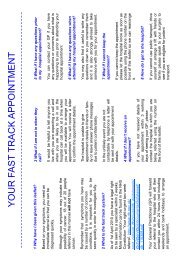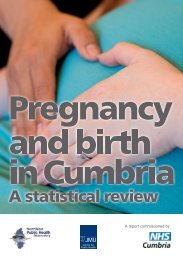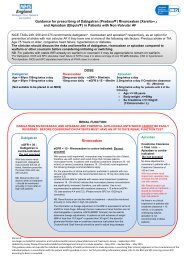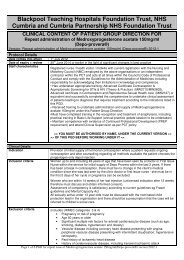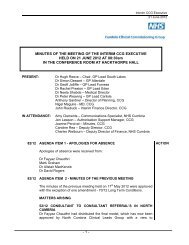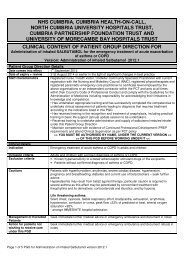Copeland Health Profile 2010 - Cumbria County Council
Copeland Health Profile 2010 - Cumbria County Council
Copeland Health Profile 2010 - Cumbria County Council
You also want an ePaper? Increase the reach of your titles
YUMPU automatically turns print PDFs into web optimized ePapers that Google loves.
<strong>Copeland</strong> <strong>Health</strong> <strong>Profile</strong> <strong>2010</strong><br />
Jennifer Clay<br />
Public <strong>Health</strong> Intelligence Analyst, NHS <strong>Cumbria</strong><br />
Index
Page<br />
Introduction 3<br />
The population of <strong>Copeland</strong> 4<br />
Births 4<br />
Population projections 5<br />
<strong>Health</strong> inequalities 6<br />
Life expectancy 9<br />
What are the main causes of disease causing<br />
the low level of life expectancy in <strong>Copeland</strong> 11<br />
Infant mortality 11<br />
Mortality during 2009 12<br />
Premature deaths from circulatory disease 13<br />
Premature deaths from cancer 14<br />
Which type of cancer 14<br />
Cancer screening 15<br />
What are the behavioural risk factors resulting in the<br />
inequalities gap in life expectancy and infant mortality 17<br />
Smoking 17<br />
Obesity 20<br />
Obesity and nutrition 23<br />
Obesity and physical activity 23<br />
Mental health 23<br />
Alcohol 24<br />
Chlamydia 26<br />
Teenage pregnancy 27<br />
Breastfeeding 27<br />
Wider determinants of health 28<br />
Work, unemployment and incapacity 28<br />
Fuel poverty 29<br />
Excess winter deaths 30<br />
Child poverty 31<br />
Educational attainment 32<br />
Household income 33<br />
Conclusion 33<br />
<strong>Copeland</strong> <strong>Health</strong> <strong>Profile</strong><br />
J Clay<br />
2
Introduction<br />
The purpose of this profile is to bring together data affecting the health and wellbeing of the<br />
people of <strong>Copeland</strong>. It is aimed at colleagues within the NHS, external partners and the third<br />
sector. Firstly, its’ content will aid future commissioning with the intention of improving health<br />
outcomes for the population of <strong>Copeland</strong>. Secondly, the report may also be useful for<br />
partners to assist them with their strategic aims around health improvement. Responding to<br />
the Coalition Government’s White Paper: Equity & Excellence: Liberating the NHS (<strong>2010</strong>)<br />
which suggests a move to locality based GP consortia commissioning arrangements where<br />
possible data are presented at GP practice level. Where this is not feasible data are at local<br />
authority level. National and county comparator information is provided.<br />
Figure 1: <strong>Copeland</strong> district council and PBC boundary<br />
<strong>Copeland</strong> <strong>Health</strong> <strong>Profile</strong><br />
J Clay<br />
3
<strong>Copeland</strong> district council covers an area of around 300 square miles. Following the<br />
introduction of Practice Based Commissioning (PBC), practices within the district formed a<br />
local consortium. This consortium does not include the GP practice located in Millom. This<br />
practice opted to join with Furness locality. Therefore the PBC boundary is not co-terminus<br />
with the district council boundary.<br />
The population of <strong>Copeland</strong><br />
Figure 2: Resident populations<br />
Resident population (thousands)<br />
ONS 2009 Exeter <strong>2010</strong><br />
94.3<br />
98.6<br />
104.7<br />
109.3<br />
103.8<br />
107.5<br />
70.9<br />
72.5<br />
69.7<br />
71.5<br />
51.8<br />
53.3<br />
Allerdale Barrow-in-Furness Carlisle <strong>Copeland</strong> Eden South Lakeland<br />
District council<br />
Figure 2 shows the latest population figures for <strong>Copeland</strong> district council. Figures provided<br />
by the Office for National Statistics (ONS) indicate a population of 69,700 (mid year<br />
population estimates). This figure increases by 3% to 71,500 when the population is taken<br />
from the Exeter patient registration system. The patient registration system tends to record a<br />
higher figure than mid year population estimates. Therefore one would expect the true<br />
population to be somewhere between the two figures. Returning to mid year estimates<br />
almost one fifth of <strong>Copeland</strong>’s residents are aged over 65 years. This compares with 16%<br />
nationally.<br />
Births<br />
Figure 2: Live birth rate trend<br />
Live birth rate per 1,000 population<br />
E&W <strong>Cumbria</strong> <strong>Copeland</strong><br />
12 . 1 12 . 5 12 . 8 13 . 0 12 . 9<br />
9.7<br />
10 . 3<br />
10 . 8<br />
9.9 10 . 1 10 . 5 10 . 3 10 . 6 10 . 3 10 . 3<br />
2005 2006 2007 2008 2009<br />
On average each year in <strong>Copeland</strong> there are around 740 live births. Latest figures for 2009<br />
show that this figure fell to 715 births. As shown in figure 2, the live birth rate in <strong>Copeland</strong> is<br />
usually above that for <strong>Cumbria</strong> but below the national average.<br />
<strong>Copeland</strong> <strong>Health</strong> <strong>Profile</strong><br />
J Clay<br />
4
Figure 3: Practice birth rate, 1.7.<strong>2010</strong><br />
<strong>Copeland</strong> PBC: practice birth rate/1,000 population as at 1st July <strong>2010</strong><br />
<strong>Copeland</strong> average<br />
12.2<br />
10.4 10.4 10.3 9.9 9.6 9.2 9.0 8.9 8.3<br />
Mansion<br />
House<br />
Surgery<br />
Catherine<br />
Street<br />
Surgery<br />
Waterloo<br />
House<br />
Surgery<br />
Distington<br />
Surgery<br />
Queen<br />
Streen<br />
Medical<br />
Practice<br />
Lowther<br />
Medical<br />
Centre<br />
Westcroft<br />
House<br />
Seascale<br />
<strong>Health</strong><br />
Centre<br />
Beech<br />
House<br />
Group<br />
Practice,<br />
Flatt Walks<br />
<strong>Health</strong><br />
Centre<br />
To have an indication of the birth rate at GP practice level, population figures have been<br />
taken from the Exeter patient registration system. By counting the number of infants aged<br />
below one year, it is possible to calculate a proxy practice birth rate, see figure 3. Using this<br />
method the average birth rate for <strong>Copeland</strong> PBC is 9 births per 1,000 registered population<br />
(July, <strong>2010</strong>). There is a wide variation in practice birth rates with Mansion House Surgery<br />
experiencing the highest rate of 12.2 births and Flatt Walks <strong>Health</strong> Centre the lowest at 8.3<br />
births.<br />
Population Projections<br />
Figure 4: Population projections (2008 based)<br />
<strong>Copeland</strong> projected population<br />
70.0<br />
70.2<br />
70.4<br />
70.6<br />
70.9<br />
71.1<br />
2008<br />
2009<br />
<strong>2010</strong><br />
2011<br />
2012<br />
2013<br />
71.4<br />
71.6<br />
71.9<br />
72.1<br />
72.4<br />
72.7<br />
73.0<br />
2014<br />
2015<br />
2016<br />
2017<br />
2018<br />
2019<br />
2020<br />
73.3<br />
73.5<br />
73.8<br />
74.0<br />
74.2<br />
74.4<br />
74.6<br />
74.7<br />
2021<br />
2022<br />
2023<br />
2024<br />
2025<br />
2026<br />
2027<br />
2028<br />
74.9<br />
75.0<br />
75.2<br />
75.3<br />
75.5<br />
2029<br />
2030<br />
2031<br />
2032<br />
2033<br />
Figure 4 shows the population projection (2008 based) trend for <strong>Copeland</strong>. By 2033,<br />
projections suggest a growth of 8% in the overall population size of <strong>Copeland</strong>. Nationally<br />
over the same period the population is projected to grow by 18%.<br />
<strong>Copeland</strong> <strong>Health</strong> <strong>Profile</strong><br />
J Clay<br />
5
Figure 5: Population projections, aged 65 plus (2008 based)<br />
% Population projection aged 65 years and over<br />
2008 2033<br />
31% 32%<br />
20% 20%<br />
27% 26%<br />
18% 18% 18%<br />
30%<br />
21%<br />
35%<br />
23%<br />
37%<br />
16%<br />
23%<br />
<strong>Cumbria</strong> Allerdale Barrow-in-<br />
Furness<br />
Carlisle <strong>Copeland</strong> Eden South<br />
Lakeland<br />
England<br />
Figure 5 examines those aged over 65 years of age. Projections suggest that this age group<br />
will increase in <strong>Copeland</strong> from 18% of the total population in 2008 to 30% by 2033. Both<br />
figures are just below the <strong>Cumbria</strong> average but above those for England.<br />
<strong>Health</strong> Inequalities<br />
In order to tackle health inequalities it is necessary to focus activities on those most in need.<br />
Using the English Indices of Deprivation 2007 which measured seven domains and combined<br />
these to produce the Index of Multiple Deprivation it is possible to identify those areas<br />
experiencing the greatest deprivation, figure 6. The geographical area the Index is based on<br />
is the lower super output area (LSOA). A LSOA nests within an existing ward. A more<br />
populous ward may contain several LSOAs, a sparsely populated ward only one. Therefore<br />
pockets of deprivation can be detected at sub-ward level.<br />
All LSOAs in England were given a score and ranked. The rank of one indicates the area with<br />
the worst deprivation in the country. Rankings were divided into quintiles (fifths) where<br />
quintile one represents the most deprived and quintile five the least deprived. Taking the<br />
quintile and using a traffic light system where red indicates the worst and dark green the best,<br />
data for <strong>Copeland</strong> district have been mapped.<br />
<strong>Copeland</strong> <strong>Health</strong> <strong>Profile</strong><br />
J Clay<br />
6
Figure 6: Index of multiple deprivation 2007<br />
<strong>Copeland</strong> <strong>Health</strong> <strong>Profile</strong><br />
J Clay<br />
7
Figure 7: Most deprived areas of <strong>Copeland</strong><br />
Figure 7 shows those areas of <strong>Copeland</strong> experiencing the worst deprivation (quintile one).<br />
Data for 2004 and 2007 have been compared to show if any area has improved. The areas<br />
that were in quintile one during 2004 have remained there. Parts of Cleator Moor North,<br />
Cleator Moor North and Newtown have joined them. The most deprived areas of <strong>Copeland</strong><br />
are listed in table 1. Currently around one quarter of <strong>Copeland</strong>’s population are living within<br />
the most deprived communities in England.<br />
<strong>Copeland</strong> <strong>Health</strong> <strong>Profile</strong><br />
J Clay<br />
8
Table 1: IMD, 2007 most deprived areas of <strong>Copeland</strong><br />
LSOA code LSOA description Estimated<br />
population<br />
England rank<br />
(1-32,482)<br />
<strong>Cumbria</strong><br />
rank (1-322)<br />
National<br />
quintile<br />
E01019301 Sandwith Part 1 1,597 293 2 1<br />
E01019295 Mirehouse Part 2 1,577 1,270 10 1<br />
E01019280 Harbour Part 1 1,525 2,658 23 1<br />
E01019267 Cleator Moor South Part 2 1,347 3,150 27 1<br />
E01019269 Distington Part 2 1,545 3,306 28 1<br />
E01019277 Frizington Part 1 1,330 3,554 30 1<br />
E01019263 Cleator Moor North Part 1 1,248 5,062 42 1<br />
E01019272 Egremont North Part 2 1,501 5,067 43 1<br />
E01019271 Egremont North Part 1 1,162 5,738 50 1<br />
E01019294 Mirehouse Part 1 1,522 5,852 51 1<br />
E01019265 Cleator Moor North Part 3 1,346 6,147 56 1<br />
E01019299 Newtown Part 2 1,981 6,485 60 1<br />
Most deprived 17,681<br />
Life expectancy<br />
Figure 8: Life expectancy trend, males and females<br />
Life Expectancy at birth<br />
Years<br />
83.0<br />
82.0<br />
81.0<br />
80.0<br />
79.0<br />
78.0<br />
77.0<br />
76.0<br />
75.0<br />
74.0<br />
73.0<br />
72.0<br />
1991-<br />
1993<br />
1992-<br />
1994<br />
1993-<br />
1995<br />
1994-<br />
1996<br />
1995-<br />
1997<br />
Eng (M) <strong>Copeland</strong> (M) Eng (F) <strong>Copeland</strong> (F)<br />
1996-<br />
1998<br />
1997-<br />
1999<br />
1998-<br />
2000<br />
1999-<br />
2001<br />
2000-<br />
2002<br />
2001-<br />
2003<br />
2002-<br />
2004<br />
2003-<br />
2005<br />
2004-<br />
2006<br />
2005-<br />
2007<br />
2006-<br />
2008<br />
The most basic way of measuring the health of a community is to look at when and how<br />
people die. Life expectancy shows the average age a child born today in an area could<br />
expect to live assuming that people are dying at the same rate and ages that we find today. It<br />
is affected by the number of people dying and the age at which they die.<br />
As shown in figure 8, over the past fifteen years there has been a steady improvement in life<br />
expectancy for men and women living in <strong>Copeland</strong>. The latest figure for female life<br />
expectancy is of concern. This shows a decrease over the previous years’ steady<br />
improvement. Life expectancy for both males and females continues to be below the national<br />
average.<br />
<strong>Copeland</strong> <strong>Health</strong> <strong>Profile</strong><br />
J Clay<br />
9
Figure 9: 2006-08, life expectancy at birth and at age 65 years, males and females<br />
Life expectancy at birth, 2006-2008<br />
<strong>Copeland</strong> <strong>Cumbria</strong> England<br />
Life expectancy at age 65 years, 2006-2008<br />
<strong>Copeland</strong> <strong>Cumbria</strong> England<br />
77.2<br />
77.8<br />
77.9<br />
79.8<br />
81.4<br />
82.0<br />
17.4<br />
17.6<br />
17.7<br />
19.1<br />
20.2<br />
20.4<br />
Males<br />
Females<br />
Males<br />
Females<br />
Figure 9 shows the average life expectancy for a man living in <strong>Copeland</strong> is 77.2 years. This<br />
compares with 77.8 years for <strong>Cumbria</strong> and 77.9 years for England. Life expectancy for<br />
women in <strong>Copeland</strong> is 79.8 years. This is below the <strong>Cumbria</strong> and National averages of 81.4<br />
82 years respectively.<br />
Once a man in <strong>Copeland</strong> has reached his 65 th year of life he can expect to live for a further<br />
17.4 years. Again this is below the county and national averages of 17.6 years and 17.7<br />
years respectively. For women aged 65 living in <strong>Copeland</strong> they can expect to live for a<br />
further 19.1 years. This is just above the <strong>Cumbria</strong> average of 20.2 years and just below the<br />
national average of 20.4 years.<br />
Figure 10: Ward life expectancy at birth, 1999 to 2003, persons<br />
Life expectancy at birth by electoral wards in <strong>Copeland</strong> (years)<br />
75 yrs<br />
82.5 81.2 81.0 80.8 80.7 80.4 79.6 79.1 79.0 79.0 78.9 78.3 77.7 77.5 77.2 76.6 76.4 76.3 76.1 76.0 75.8 75.2 74.2 73.2 73.1<br />
Beckermet<br />
St Bees<br />
Haverigg<br />
Gosforth<br />
Seascale<br />
Bransty<br />
Cleator Moor North<br />
Millom Without<br />
Arlecdon<br />
Bootle<br />
Hillcrest<br />
Egremont North<br />
Ennerdale<br />
Holborn Hill<br />
Ward<br />
Consdideration should be given to the location of medical & care establishements<br />
Hensingham<br />
Distington<br />
Egremont South<br />
Frizington<br />
Cleator Moor South<br />
Newtown<br />
Kells<br />
Sandwith<br />
Moresby<br />
Mirehouse<br />
Harbour<br />
Wider variations in life expectancy can be found when looking at data at sub-district level, see<br />
figure 10. Someone living in the ward of Beckermet has an average life expectancy of 82.5<br />
years. Whereas their opposite number living in Harbour ward has a life expectancy of 73.1<br />
years. In other words they die 9.4 years earlier! People living in the wards of Moresby,<br />
Mirehouse and Harbour can expect to die “prematurely” as all three wards have an average<br />
live expectancy of below 75 years of age. A cautionary note must be sounded when looking<br />
at data at a lower level. The location of medical and care establishments should be taken into<br />
consideration when looking at sub-district data. The number of residents within these<br />
establishments will impact on an areas life expectancy.<br />
<strong>Copeland</strong> <strong>Health</strong> <strong>Profile</strong><br />
J Clay<br />
10
What are the main diseases causing the low level of life expectancy in <strong>Copeland</strong><br />
Figure 11: Life expectancy gap and cause of death (The Association of Public <strong>Health</strong> Observatories)<br />
Most of the difference between life expectancy in <strong>Copeland</strong> and the average for England as a<br />
whole is related to three main groups of diseases and conditions: circulatory diseases, cancer<br />
and respiratory diseases. Figure 11 shows the proportion of the gap in life expectancy that is<br />
attributed to these causes. It appears that external causes, particularly amongst men in<br />
<strong>Copeland</strong>, also accounts for a considerable gap in life expectancy.<br />
Infant mortality<br />
Figure 12: Infant mortality trend<br />
Infant death rate per 1,000 live births<br />
E&W <strong>Cumbria</strong> <strong>Copeland</strong><br />
8.0<br />
5.0 4.4<br />
5.0 4.7 4.8 4.4 4.8 4.9<br />
3.9 4.1<br />
4.7<br />
1.4<br />
3.5<br />
1.4<br />
2005 2006 2007 2008 2008<br />
Infant mortality is a good indicator of the overall health of a society. On average each year in<br />
<strong>Copeland</strong> three infants die before reaching their first birthday. As shown in figure 13 infant<br />
mortality rates are at an all time low. In 2009 the mortality rate in <strong>Copeland</strong> was 1.4 deaths<br />
for every 1,000 live births. This is well below the national average of 4.7 deaths per 1,000 live<br />
births and that of <strong>Cumbria</strong> (3.5 deaths per 1,000). The number of deaths has fallen from five<br />
<strong>Copeland</strong> <strong>Health</strong> <strong>Profile</strong><br />
J Clay<br />
11
during 2008 to one death. Infant mortality is mainly as a result of: immaturity, low birth<br />
weight, sudden unexpected death in infancy, congenital malformations and infection.<br />
The emphasis on reducing smoking during pregnancy, teenage pregnancy obesity, improved<br />
parental nutrition and an increase in breast feeding contribute to reducing the number of<br />
deaths in the first year of life.<br />
Mortality during 2009<br />
Figure 13: Mortality in <strong>Copeland</strong>, 2009<br />
<strong>Copeland</strong> mortality, 2009 by age group<br />
Percentage<br />
100%<br />
90%<br />
80%<br />
70%<br />
60%<br />
50%<br />
40%<br />
30%<br />
20%<br />
10%<br />
0%<br />
0-74 years 75+ years<br />
194<br />
263<br />
457<br />
142<br />
107 249<br />
Male Female Persons<br />
During 2009 in <strong>Copeland</strong> there were 706 deaths, see figure 13. This is a 5% reduction on<br />
the previous years’ figure of 746 deaths. Just over a third of all deaths in 2009 were to people<br />
aged below 75 years of age. In terms of gender, just over two fifths of all male deaths were<br />
premature. For women, over one quarter of all deaths is classed as premature. Premature<br />
mortality during 2009 fell by 16% when compared with the previous year (295 deaths). There<br />
was an 18% reduction in the number early deaths in females during the year. Male deaths<br />
declined by 14%.<br />
Figure 14: All age mortality: cause of death in <strong>Copeland</strong>, 2009<br />
<strong>Copeland</strong> mortality, all ages, 2009<br />
Circulatory, 30% Circulatory, 34%<br />
Cancer, 30% Cancer, 25%<br />
Respiratory , 13%<br />
Respiratory , 16%<br />
Digestive, 7%<br />
Digestive, 4%<br />
Other , 19% Other , 22%<br />
Male<br />
Female<br />
Figure 14 shows the main causes of death in <strong>Copeland</strong> during 2009. Almost three quarters<br />
of all deaths can be attributed to three disease groups: circulatory diseases, malignant<br />
cancers and respiratory diseases.<br />
<strong>Copeland</strong> <strong>Health</strong> <strong>Profile</strong><br />
J Clay<br />
12
Figure 15: Premature mortality: cause of death in <strong>Copeland</strong>, 2009<br />
<strong>Copeland</strong> premature mortality, 2009<br />
Cancer, 34%<br />
Cancer, 44%<br />
Circulatory, 32%<br />
Circulatory, 21%<br />
Respiratory , 13% Respiratory , 12%<br />
Digestive, 4% Digestive, 6%<br />
Other , 18% Other , 18%<br />
Male<br />
Female<br />
Figure 15 shows premature mortality by main cause of death. For this age group cancer is<br />
the primary cause of death, accounting for almost two out of five deaths. Proportionately<br />
more women than men will die from cancer in this age group.<br />
Premature deaths from circulatory disease<br />
The main behavioural risk factors that contribute to high levels of circulatory disease are:<br />
smoking, diet and levels of physical activity. In <strong>Copeland</strong> premature mortality for this disease<br />
group are above the county and national level for males and females.<br />
Figure 16: Premature mortality from circulatory disease by gender<br />
DSR<br />
Premature Mortality: All circulatory disease, males<br />
(directly standardised rates)<br />
210.0<br />
190.0<br />
170.0<br />
150.0<br />
130.0<br />
110.0<br />
90.0<br />
England <strong>Cumbria</strong> <strong>Copeland</strong><br />
2001 2002 2003 2004 2005 2006 2007 2008<br />
DSR<br />
100.0<br />
90.0<br />
80.0<br />
70.0<br />
60.0<br />
50.0<br />
40.0<br />
30.0<br />
Premature Mortality: All circulatory disease, females<br />
(directly standardised rates)<br />
England <strong>Cumbria</strong> <strong>Copeland</strong><br />
2001 2002 2003 2004 2005 2006 2007 2008<br />
Figure 16 shows the trend in premature mortality from circulatory diseases. Until 2008 there<br />
was a general downward trend in mortality for both sexes. During the year the male mortality<br />
rate increased to 127 deaths per 100,000 men (53 deaths); placing it above the county and<br />
national rate of around 100 males deaths per 100,000. Recent figures for 2009 show that the<br />
number of deaths has fallen by 15% to 45 deaths. During 2008 female mortality rates<br />
increased to 62 deaths per 100,000 women (28 deaths). This is above county and national<br />
rates of 49 female deaths per 100,000 and 44 female deaths per 100,000 respectively.<br />
Figures for 2009 show that the number of deaths reduced by 21% to 22 female deaths.<br />
<strong>Copeland</strong> <strong>Health</strong> <strong>Profile</strong><br />
J Clay<br />
13
Premature deaths from cancer<br />
The risk of developing cancer depends on many factors: including age, lifestyle and genetic<br />
make-up. It is estimated that up to half of all cancers could be avoided if people made<br />
changes to their lifestyles such as stopping smoking, moderate alcohol intake, maintaining a<br />
healthy bodyweight and avoiding excessive sun exposure. Early detection and increased<br />
awareness of screening interventions such as colorectal, breast and cervical screening<br />
provide an opportunity to reduce premature mortality rates.<br />
Figure 17: Premature mortality from cancer by gender<br />
Premature Mortality: All cancers, males<br />
(directly standardised rates)<br />
Premature Mortality: All cancers, females<br />
(directly standardised rates)<br />
England <strong>Cumbria</strong> <strong>Copeland</strong><br />
England <strong>Cumbria</strong> <strong>Copeland</strong><br />
DSR<br />
190.0<br />
170.0<br />
150.0<br />
130.0<br />
110.0<br />
90.0<br />
2001 2002 2003 2004 2005 2006 2007 2008<br />
DSR<br />
140.0<br />
130.0<br />
120.0<br />
110.0<br />
100.0<br />
90.0<br />
80.0<br />
70.0<br />
60.0<br />
2001 2002 2003 2004 2005 2006 2007 2008<br />
Figure 17 shows premature mortality rates from cancer. Male mortality of 124 deaths per<br />
100,000 (56 deaths) men is in line with the national average and below the county rate of 164<br />
deaths per 100,000. Recently released figures for 2009 reveal that the number of male<br />
deaths has decreased by 14% to 48 deaths. During recent years female mortality from<br />
cancer has show a steady increase. The current rate of 131 deaths per 100,000 females (57<br />
deaths) is above the county and national rate of 100 deaths for every 100,000 females.<br />
Figures for 2009 show that the number of female deaths decreased by 18% to 47 deaths.<br />
Which type of cancer<br />
Table 2 shows standardised mortality ratios (SMRs). These are used to measure the ratio of<br />
deaths in a standard population, in this case England, with a study population (<strong>Copeland</strong>).<br />
The standard population is measured as 100 and the study population is compared with this.<br />
Anything above 100 is worse than average and anything below is better. A statistical test is<br />
applied to the SMR to identify if it is significantly better or worse than would be expected. In<br />
this instance this significance is represented by “faces”. A sad face (red) represents worse<br />
than expected and a happy face (green) better than expected when compared to the national<br />
average.<br />
<strong>Copeland</strong> <strong>Health</strong> <strong>Profile</strong><br />
J Clay<br />
14
Table 2: Cancer trend by site and gender, under 75 years<br />
Males Deaths SMR with statistical significance<br />
Site ICD No. 02-04 03-05 04-06 02-04 03-05 04-06<br />
All cancers C00-C97 154 178 182 93 108 110<br />
MN Oesophagus C15 7 10 12 64 89 106<br />
MN Stomach C16 6 10 7 84 144 106<br />
MN Colon/Rectum C18-C20 22 22 21 127 126 121<br />
MN Pancreas C25 7 6 7 89 73 83<br />
MN Trachea,Bronchus,Lung C33-C34 40 45 46 93 106 108<br />
Mal Melanoma Skin C43 .. 5 6 .. 186 213<br />
Mesothelioma C45 .. .. 5 .. .. 119<br />
MN Prostate C61 11 13 17 92 108 142<br />
MN Kidney ex Renal Pelvis C64 7 .. .. 144 .. ..<br />
MN Bladder C67 .. .. .. .. .. ..<br />
MN Brain C71 6 7 6 97 111 93<br />
Non-Hodgkin's Lymphoma C82-C85 .. 5 6 .. 89 110<br />
Leukaemia C91-C95 5 7 7 100 137 136<br />
Females<br />
All cancers C00-C97 138 130 135 104 98 102<br />
MN Oesophagus C15 .. .. .. .. .. ..<br />
MN Stomach C16 4 5 7 133 170 254 <br />
MN Colon/Rectum C18-C20 9 11 11 85 117 132<br />
MN Pancreas C25 9 8 .. 150 128 ..<br />
MN Trachea, Bronchus, Lung C33-C34 29 23 27 113 89 101<br />
Mal Melanoma Skin C43 .. .. .. .. .. ..<br />
Mesothelioma C45 .. .. .. .. .. ..<br />
MN Female Breast C50 30 24 22 115 91 84<br />
MN Cervix Uteri C53 .. .. .. .. .. ..<br />
MN Uterus C54 .. .. .. .. .. ..<br />
MN Ovary C56 8 12 13 76 116 129<br />
MN Kidney ex Renal Pelvis C64 .. .. .. .. .. ..<br />
MN Bladder C67 .. .. .. .. .. ..<br />
MN Brain C71 5 6 6 127 155 155<br />
Non-Hodgkin's Lymphoma C82-C85 .. .. .. .. .. ..<br />
Leukaemia C91-C95 .. .. .. .. .. ..<br />
.. Data suppressed (less than five deaths)<br />
Cancer screening<br />
Currently there are three national screening programmes operating within the district. These<br />
are: cervical – screening women aged 25 to 64 years, breast – screening women aged 53 to<br />
64 years and bowel screening. Originally bowel screening was offered to men and women<br />
aged 60 to 69 years. This has recently been extended to include the age group 70 to 75<br />
years. Latest coverage figures are shown in table 3.<br />
<strong>Copeland</strong> <strong>Health</strong> <strong>Profile</strong><br />
J Clay<br />
15
Table 3: Screening coverage<br />
2009/10 2009 2009/10<br />
Area Breast Bowel Cervical<br />
<strong>Copeland</strong> 83% 59% 82%<br />
<strong>Cumbria</strong> 82% 60% 82%<br />
England *77% 52% 79%<br />
*2008/09 coverage<br />
Generally <strong>Copeland</strong> performs well when compared with screening averages locally and<br />
nationally.<br />
Figure 18: Screening coverage by GP practice<br />
90%<br />
85%<br />
<strong>Copeland</strong> PBC: Screening covverage<br />
Breast Bowel Cervical<br />
80%<br />
75%<br />
Coverage<br />
70%<br />
65%<br />
60%<br />
55%<br />
50%<br />
45%<br />
40%<br />
Hinnings<br />
Road<br />
Surgery<br />
Seascale<br />
<strong>Health</strong><br />
Centre<br />
Catherine<br />
Street<br />
Surgery<br />
Lowther<br />
Medical<br />
Centre<br />
Flatt Walks<br />
<strong>Health</strong><br />
Centre<br />
Beech<br />
House Group<br />
Practice<br />
Queen<br />
Street<br />
Medical<br />
Practice<br />
Trinity House<br />
Surgery<br />
Westcroft<br />
House<br />
Mansion<br />
House<br />
Surgery<br />
Practice<br />
Figure 18 examines screening coverage by GP practice. There is a varied picture across the<br />
locality with cervical screening coverage ranging from 76% to 85% of the target population.<br />
Moving to breast screening, coverage ranges from 78% to 87%. Finally bowel screening<br />
coverage varies from 54% to 62% of the target population.<br />
<strong>Copeland</strong> <strong>Health</strong> <strong>Profile</strong><br />
J Clay<br />
16
What are the main behavioural risk factors resulting in the inequalities gap in life<br />
expectancy and infant mortality<br />
Figure 19: Behavioural risk factors<br />
There are six main behavioural risk factors that contribute to poor health and health<br />
inequalities: diet, physical exercise, smoking alcohol consumption, teenage pregnancy and<br />
breast feeding. Their impact on health is illustrated in figure 22. These risk factors will be<br />
discussed in the following sections.<br />
Smoking<br />
Smoking is the biggest preventable single cause of preventable illness and death in the UK.<br />
About 90% of lung cancer deaths and 17% of coronary heart disease are attributable to<br />
smoking (ASH, 2007). Smoking during pregnancy is estimated to increase infant mortality by<br />
about 40% (DoH 2007).<br />
Figure 20: Estimated smoking prevalence<br />
Figure 20 takes data from the Joint Strategic Needs Assessment, 2009 report. This shows<br />
that smoking prevalence within <strong>Copeland</strong> is well above the <strong>Cumbria</strong> average.<br />
<strong>Copeland</strong> <strong>Health</strong> <strong>Profile</strong><br />
J Clay<br />
17
Figure 21: Smoking status by GP practice, June <strong>2010</strong><br />
Smoking status by practice: current smoker<br />
20%<br />
17% 17% 17% 16% 15% 14% 14% 14% 14%<br />
Lowther<br />
Medical<br />
Centre<br />
Flatt Walks<br />
<strong>Health</strong><br />
Centre<br />
Church<br />
Street<br />
Surgery<br />
Beech<br />
House<br />
Group<br />
Practice<br />
Westcroft<br />
House<br />
Drs Timney<br />
& Westhead<br />
Catherine<br />
Street<br />
Surgery<br />
Distington<br />
Seascale<br />
<strong>Health</strong><br />
Centre<br />
Ironside &<br />
Ironside<br />
It is difficult to quantify the number of people who smoke. Figure 21 takes data from GP<br />
practice registers. This shows the number of patients aged 16 and over, whose smoking<br />
status has been recorded in the last 15 months with latest status recorded as current smoker.<br />
Smokers ranged from 20% of the register to 14%. Using this methodology almost 7,000<br />
current smokers had visited their GP.<br />
Data collected by the <strong>Cumbria</strong> Stop Smoking Service sows that during the financial year<br />
2009/10, 1,167 residents of <strong>Copeland</strong> approached the service for help with quitting smoking.<br />
Of these just over two thirds successful quit smoking. Just over one fifth were unsuccessful.<br />
Another source of smoking data is the local tobacco control profiles produced by the<br />
Association of Public <strong>Health</strong> Observatories. Results for <strong>Copeland</strong> are shown in figures 21<br />
and 22.<br />
Figure 21: Local tobacco control profile, part 1<br />
<strong>Copeland</strong> <strong>Health</strong> <strong>Profile</strong><br />
J Clay<br />
18
Figure 22: Local tobacco control profile, part 1<br />
<strong>Copeland</strong> <strong>Health</strong> <strong>Profile</strong><br />
J Clay<br />
19
Obesity<br />
Obesity is when a person is carrying too much body fat for their height and sex. A person is<br />
considered obese if they have a body mass index (BMI) of 30 or greater. In 2008 nearly a<br />
quarter of all adults (16 plus) in England were obese. Just under one third of women, 32%,<br />
were overweight (a BMI of 25-30), and 42% of men were overweight (NHS Choices <strong>2010</strong>).<br />
The number of overweight and obese people is likely to increase. The Foresight (2007)<br />
report, a scientific report used to guide Government policy, has predicted that by 2025, nearly<br />
half of men and over one third of women will be obese. Obesity can cause a number of<br />
health problem, such as type 2 diabetes and heart disease. Being overweight or obese can<br />
also shorten life expectancy.<br />
Figure 23: Patients with Body Mass Index >=30, (January 2009 to March <strong>2010</strong>)<br />
Patients over 16 with BMI of >=30<br />
16.3% 16.1% 15.7% 15.0% 14.9%<br />
12.9% 12.8%<br />
10.9% 10.7%<br />
7.4%<br />
Hinnings<br />
Road<br />
Surgery<br />
Lowther<br />
Medical<br />
Centre<br />
Catherine<br />
Street<br />
Surgery<br />
Mansion<br />
House<br />
Surgery<br />
Westcroft<br />
House<br />
Queen<br />
Street<br />
Medical<br />
Practice<br />
Seascale<br />
<strong>Health</strong><br />
Centre<br />
Flatt Walks<br />
<strong>Health</strong><br />
Centre<br />
Beech<br />
House<br />
Group<br />
Practice<br />
Trinity<br />
House<br />
Surgery<br />
Data taken from the GP QOF (Quality and Outcomes Framework) registers shows a varied<br />
picture across <strong>Copeland</strong> regarding obesity, see figure 23. Of those patients measured as<br />
many as 16% and as few as 7% were recorded as obese when viewed at practice level.<br />
Looking at <strong>Copeland</strong> as a whole this converts to an average obesity rate of 13%. This is<br />
above the county average of 10.5%.<br />
Data taken from the NHS <strong>Cumbria</strong> Obesity Atlas <strong>2010</strong> examines QOF data in more detail for<br />
the period 2006/09. This is shown in table 4. Here data are shown at ward level with a<br />
district and county comparison. The table shows firstly: of those patients who have been<br />
weighed the proportion classified as obese. Secondly of the obese group of patients the<br />
proportion of that group who are also suffering from a long term condition. It must be<br />
remembered that not all of a practices population have been measured. On average 40% of<br />
patients in <strong>Copeland</strong> had their BMI recorded during the period.<br />
<strong>Copeland</strong> <strong>Health</strong> <strong>Profile</strong><br />
J Clay<br />
20
Table 4: Patients recorded with a BMI >=30 and a long term health condition, ward (percentage)<br />
Obese with:<br />
Ward Total Obese Asthma Diabetes COPD CHD Hypertension<br />
Arlecdon 31.7 18.9 20.0 3.4 13.7 38.3<br />
Beckermet 32.6 18.5 18.8 1.2 15.8 49.3<br />
Bootle 30.5 20.1 16.0 5.7 10.3 50.0<br />
Bransty 29.2 15.9 17.7 2.6 10.5 32.8<br />
Cleator Moor North 37.8 15.5 23.4 1.3 13.9 43.1<br />
Cleator Moor South 36.2 21.5 23.8 4.5 12.5 44.7<br />
Distington 35.2 16.6 17.6 3.7 10.4 33.6<br />
Egremont North 36.7 20.0 22.4 4.7 15.3 39.2<br />
Egremont South 31.9 21.5 21.1 3.5 17.4 54.9<br />
Ennerdale 28.2 15.3 20.0 3.5 15.3 34.1<br />
Frizington 36.0 20.4 20.8 2.8 13.5 33.6<br />
Gosforth 26.6 19.3 22.4 3.1 11.8 44.7<br />
Harbour 30.0 17.4 19.4 4.5 12.3 39.3<br />
Haverigg 37.7 17.9 51.2 0.0 20.2 44.0<br />
Hensingham 34.1 20.0 19.8 3.1 11.4 41.9<br />
Hillcrest 25.5 15.6 10.7 1.8 11.6 37.9<br />
Holborn Hill 30.1 18.5 45.2 0.0 12.9 40.3<br />
Kells 32.4 15.6 15.6 2.8 8.9 39.6<br />
Millom Without 27.2 12.3 23.6 5.7 12.3 34.9<br />
Mirehouse 32.9 18.8 20.6 5.4 14.7 32.7<br />
Moresby 34.1 16.7 17.3 3.0 7.1 37.5<br />
Newtown 36.8 24.0 41.2 1.4 18.1 38.0<br />
St Bees 23.5 20.3 15.8 3.0 10.5 43.6<br />
Sandwith 34.2 23.8 21.0 5.0 11.6 30.4<br />
Seascale 28.0 15.1 15.1 1.4 7.4 43.7<br />
In addition to information from QOF the National Child Measurement Programme (NCMP)<br />
also provides data around young people. Reception year and year 6 pupils are measured. In<br />
<strong>Cumbria</strong> during 2009/10 of those eligible: 89% of reception year pupils were measured and<br />
86% of pupils in year 6.<br />
<strong>Copeland</strong> <strong>Health</strong> <strong>Profile</strong><br />
J Clay<br />
21
Figure 24: Reception year obesity prevalence by district council<br />
NCMP: Reception obesity prevalence 08/09 - 09/10<br />
2008/09 2009/10<br />
14%<br />
10% 10%<br />
9%<br />
10%<br />
6%<br />
8%<br />
12%<br />
8%<br />
10%<br />
12%<br />
11%<br />
8%<br />
8%<br />
7%<br />
8%<br />
England <strong>Cumbria</strong> Allerdale Barrow-in-<br />
Furness<br />
Carlisle <strong>Copeland</strong> Eden South<br />
Lakeland<br />
Figure 24 shows reception year data for 2009/10. In <strong>Copeland</strong> 1% of children were recorded<br />
as obese. This is a slight reduction over the previous year’s figure of 12%. Current obesity<br />
rates are just above county and national averages.<br />
Figure 25: Year 6 obesity prevalence by district council<br />
NCMP: Year 6 obesity prevalence 08/09 - 09/10<br />
2008/09 2009/10<br />
20%<br />
18%<br />
19% 19%<br />
21%<br />
20%<br />
21% 21%<br />
19%<br />
19%<br />
20% 20%<br />
19% 19%<br />
17%<br />
16%<br />
England <strong>Cumbria</strong> Allerdale Barrow-in-<br />
Furness<br />
Carlisle <strong>Copeland</strong> Eden South<br />
Lakeland<br />
Figure 25 shows the results for year 6 students. In <strong>Copeland</strong> 20% of pupils are recorded as<br />
being obese. This is slightly above national and county averages.<br />
<strong>Copeland</strong> <strong>Health</strong> <strong>Profile</strong><br />
J Clay<br />
22
Obesity and nutrition<br />
The Government recommends an intake of at least five portions of fruit or vegetables per<br />
person per day to help reduce the risk of some cancers, heart disease and many other<br />
chronic conditions.<br />
Figure 26: Fruit and vegetable consumption<br />
Figure 26 takes data from the <strong>Health</strong> Survey England. This shows that an estimated 26% of<br />
the population of <strong>Copeland</strong> reported eating five or more pieces of fruit and vegetables per<br />
day. This is slightly worse than the <strong>Cumbria</strong> average of 28%.<br />
Obesity and Physical activity<br />
Adults who are physically active have a 20-30% reduced risk of premature death (DoH 2004).<br />
Physical activity has an effect on cardiovascular risk, it reduces the risk of some cancers such<br />
as colorectal cancer, and it reduces the incidence of falls and osteoporosis in the elderly, and<br />
has been shown to reduce depression, stress and anxiety (DoH 2004).<br />
The National Indicator, N18 measures the percentage of the adult population (age 16 years<br />
and over) in a local area who participate in sport and active recreation, at moderate intensity,<br />
for at least 30 minutes on at least 12 days out of the last 4 weeks (equivalent to 30 minutes<br />
on 3 or more days a week). Figures taken from Sport England show that just over 20% of the<br />
adult population of <strong>Copeland</strong> participate in some form of physical activity. This is below the<br />
<strong>Cumbria</strong> average of 22%.<br />
Mental <strong>Health</strong><br />
Mental well-being is as important as physical health if people are to live their lives to the full.<br />
Mental ill-health is common with one in four people experiencing a mental health problem at<br />
some point in their life. Ten percent of children have a mental health problem.<br />
Table 5: Selected mental health indicators<br />
Indicator<br />
Number<br />
Estimated number of people with a common mental disorder 7,300<br />
Estimated number of people age over 65 with dementia 800<br />
Estimated number of adults (16+) who have engaged in deliberate self harm in their 1,970-2,840<br />
lifetime<br />
Admissions to hospital for self harm 150<br />
Attendances at A&E departments in a year 440<br />
Average number of suicides each year 11<br />
The recent Mental <strong>Health</strong> Joint Strategic Needs Assessment: Adults report (NHS <strong>Cumbria</strong><br />
<strong>2010</strong>) provides valuable information on the mental health of the local community. Data taken<br />
from this report are shown in table 5. This shows a selection of mental health problems<br />
experienced by the residents of <strong>Copeland</strong>.<br />
<strong>Copeland</strong> <strong>Health</strong> <strong>Profile</strong><br />
J Clay<br />
23
Figure 27: Trend for suicide and injury undetermined, persons<br />
20.0<br />
18.0<br />
16.0<br />
14.0<br />
12.0<br />
10.0<br />
8.0<br />
6.0<br />
4.0<br />
Suicide & injury undetermined, DSR<br />
1995 1996 1997 1998 1999 2000 2001 2002 2003 2004 2005 2006 2007 2008<br />
12.55<br />
England <strong>Cumbria</strong> <strong>Copeland</strong><br />
Looking at a more specific area of mental health, namely suicides; figure 27 shows the trend<br />
in <strong>Copeland</strong>. This compares the local directly standardised rate (DSR) with the county and<br />
national averages. On the whole the suicide rate for <strong>Copeland</strong> tends to be above the national<br />
and county level.<br />
Figure 28: Suicide and injury undetermined, 2006-08<br />
DSR:suicides & injury undetermined 2006-08<br />
15.5 11.3 10.9 9.9 8.2 6.6 5.3 7.8<br />
<strong>Copeland</strong> Carlisle Allerdale <strong>Cumbria</strong> South<br />
Lakeland<br />
Eden<br />
Barrow-in-<br />
Furness<br />
England<br />
To smooth out the peaks and troughs in annual statistics, figure 28 compares the three year<br />
average for suicides. With a rate of 15.5 suicides for every 100,000 people, <strong>Copeland</strong> is well<br />
above the county and national averages.<br />
Alcohol<br />
High levels of alcohol consumption will increase the risk of several cancers (liver, oral,<br />
pharynx and oesophagus), liver cirrhosis and circulatory disease. Alcohol consumption also<br />
has an impact on accidents, violent incidents and mental health disorders.<br />
Figure 29 takes data from the Local Alcohol <strong>Profile</strong>s for England <strong>2010</strong> and show that<br />
<strong>Copeland</strong> is significantly worse than average for the following:<br />
• Alcohol specific hospital admissions - under 18 years<br />
• Alcohol specific hospital admissions - males<br />
• Hospital admissions for alcohol related harm<br />
• Alcohol-attributable violent crime<br />
• Claimants on incapacity benefit – working age<br />
• Mortality from land transport accidents<br />
<strong>Copeland</strong> <strong>Health</strong> <strong>Profile</strong><br />
J Clay<br />
24
Figure 29: Local alcohol profile, <strong>Copeland</strong><br />
<strong>Copeland</strong> <strong>Health</strong> <strong>Profile</strong><br />
J Clay<br />
25
Figure 30: Hospital admissions for wholly attributable alcohol related conditions, patients<br />
Patients admitted to hospital with a wholly attributable alcohol related<br />
condition<br />
<strong>Cumbria</strong><br />
Rate/1,000<br />
7.0<br />
6.0<br />
5.0<br />
4.0<br />
3.0<br />
2.0<br />
1.0<br />
0.0<br />
Trinity House Surgery<br />
Catherine Street Surgery<br />
Flatt Walks <strong>Health</strong> Centre<br />
Lowther Medical Centre<br />
Beech House Group Pr...<br />
Westcroft House<br />
Mansion House Surgery<br />
Queen Street Medical ...<br />
Distington Surgery<br />
Seascale <strong>Health</strong> Centre<br />
Alcohol related health problems can be divided into two groups: those conditions that are<br />
wholly attributable to alcohol and those that are partially attributable to alcohol. Figure 30<br />
takes data from the report: NHS <strong>Cumbria</strong>: Hospital admissions for alcohol specific conditions,<br />
2009. Concentrating on wholly attributable conditions the chart shows hospital admission rate<br />
for patients registered with GPs in <strong>Copeland</strong>. The chart clearly shows those practices above<br />
the <strong>Cumbria</strong> average rate of 2.6 patients per 1,000 practice population aged over ten years.<br />
Chlamydia<br />
Chlamydia is a sexually transmitted infection (STI) caused by the bacterium chlamydia<br />
trachomatis. In the UK, the numbers of diagnoses of the infection have been steadily<br />
increasing each year since the mid 1990’s, and it has now become the most commonly<br />
diagnosed STI. Chlamydia is called the “silent” disease because most people who get it do<br />
not experience any noticeable symptoms.<br />
Table 6: Chlamydia screening<br />
Chlamydia 2009/10 <strong>Cumbria</strong> England<br />
Chlamydia tests reported to the National Chlamydia Screening Programme<br />
8,944<br />
(NCSP)<br />
Laboratory reports of chlamydia tests not reported directly to NCSP 2682<br />
Total test 11,626<br />
Resulting positive tests 739<br />
% young people testing positive 6.4% 6.0%<br />
Target population aged 15 -24 years 58,100<br />
% population tested 20.0% 22.1%<br />
Young people under 25 are more likely to be infected. A national screening programme has<br />
been established to test this age group. Not all tests are reported through the national<br />
screening programme. Tests generated in GP surgeries are processed directly by the<br />
laboratories and not reported to the local screening programme. A national target to test 25%<br />
of the population by the end of 2009/10 was set. Due to the nature of how the data are<br />
collected it is not possible to produce an accurate picture of local coverage. However<br />
<strong>Cumbria</strong> achieved coverage of 20% compared with 22% for England; both below target see<br />
table 6.<br />
<strong>Copeland</strong> <strong>Health</strong> <strong>Profile</strong><br />
J Clay<br />
26
Teenage pregnancy<br />
Teenage pregnancy is thought to have various effects on the health and socio-economic<br />
position of both mother and baby. Teenage mothers tend to end up being poorer, having<br />
lower educational attainment and worse mental health as compared to other women from<br />
similar backgrounds (<strong>Health</strong> Development Agency 2004).<br />
Figure 31: Trend in teenage pregnancy (below 18 years of age)<br />
55.0<br />
50.0<br />
45.0<br />
40.0<br />
35.0<br />
30.0<br />
Teenage pregnancy rate/1,000 women (15-17 yrs)<br />
England <strong>Cumbria</strong> <strong>Copeland</strong><br />
1998-00 2001-03 2004-06 2005-07 2006-08<br />
As shown in figure 31 teenage pregnancy rates in <strong>Copeland</strong> are above county and national<br />
levels. Currently in <strong>Copeland</strong> there are 47 conceptions for every 1,000 girls aged 15 to 17<br />
years. 43% of these young women chose to have their pregnancy terminated. This is below<br />
the county and national rate of 50%.<br />
Breastfeeding<br />
Evidence suggests that breastfeeding for at least the first six months of a baby’s life provides<br />
significant benefits for both the mother and baby. These benefits include: reducing the risk of<br />
developing diabetes in childhood, fewer respiratory tract infections, middle-ear infections and<br />
gastroenteritis. Babies are also less likely to develop allergies, such as asthma and eczema<br />
if they have bee breast fed.<br />
Figure 32: Breast feeding initiation rates<br />
Breast feeding initiation rates<br />
(Source: Vital Signs DoH)<br />
England<br />
<strong>Cumbria</strong><br />
72.7% 73.1% 72.6% 72.7% 73.4%<br />
69.7% 69.2%<br />
65.5%<br />
69.0%<br />
66.9%<br />
2009/10 Q1 2009/10 Q2 2009/10 Q3 2009/10 Q4 <strong>2010</strong>/11 Q1<br />
Breast feeding initiation rates in <strong>Cumbria</strong> continue to be below the national average, see<br />
figure 32. Currently in <strong>Cumbria</strong> 67% of new babies are breast fed. Once the baby has gone<br />
home breast feeding status is recorded at 6-8 weeks of age. By this stage breast feeding<br />
rates in <strong>Cumbria</strong> have fallen to 31% compared to 48 nationally.<br />
<strong>Copeland</strong> <strong>Health</strong> <strong>Profile</strong><br />
J Clay<br />
27
Figure 33: Prevalence of breast feeding at 6-8 weeks, locality<br />
Prevelance breast feeding 6-8 weeks<br />
as at quarter 2, <strong>2010</strong>/11<br />
47%<br />
29%<br />
32%<br />
29%<br />
28%<br />
18%<br />
20%<br />
Allerdale<br />
Barrow in<br />
Furness<br />
Carlisle <strong>Copeland</strong> Eden South<br />
Lakes<br />
<strong>Cumbria</strong><br />
Breast feeding prevalence data at 6 to 8 weeks are shown in figures 33 and 34. Latest<br />
figures (quarter 2, <strong>2010</strong>/11) show prevalence of 29% in <strong>Copeland</strong>. This is just above the<br />
<strong>Cumbria</strong> average of 28%. Figure 34 breaks this figure down by GP practice. A wide<br />
variation is shown at this level, ranging from 13% to 46% of mothers still breast feeding their<br />
babies at six to eight weeks.<br />
Figure 34: Prevalence of breast feeding at 6-8 weeks, GP practice<br />
Prevalence breast feeding 6-8 weeks<br />
as at quarter 2, <strong>2010</strong>/11<br />
20%<br />
23% 23%<br />
26%<br />
28%<br />
33%<br />
36%<br />
41%<br />
46%<br />
13%<br />
Distington Surgery<br />
Trinity House Surgery<br />
Mansion House Surgery<br />
Catherine Street Surgery<br />
Beech House Group Practice<br />
Lowther Medical Centre<br />
Flatt Walks <strong>Health</strong> Centre<br />
Queet Streen Medical Practice<br />
Westcroft House<br />
Seascale <strong>Health</strong> Centre<br />
Wider determinants of health<br />
It is important to remember that behavioural factors are not the only influences on health.<br />
Social and economic circumstances affect how people behave and consequently their health.<br />
Work, unemployment and incapacity<br />
Being in good employment is protective of health. Conversely, unemployment contributes to<br />
poor health. Getting people back into employment is crucial for reducing health inequalities.<br />
<strong>Copeland</strong> <strong>Health</strong> <strong>Profile</strong><br />
J Clay<br />
28
However, jobs need to be sustainable and offer a minimum level of quality that not only<br />
includes a decent living wage but also the opportunities for in-work development.<br />
Figures for 2009/10 (July 09/June10) showed that in <strong>Copeland</strong> 73.8% of the populations (16<br />
to 64 years) were economically active. This is below the national averaged for Great Britain<br />
of 76.4%. The unemployment rate was 6.8% in <strong>Copeland</strong> compared with 7.7% nationally.<br />
During <strong>2010</strong> in <strong>Copeland</strong>, full-time gross weekly pay was £622.<br />
national rates of £471 and £502 respectively.<br />
This is above regional and<br />
Table 7: Benefit claimants<br />
Working age key benefit claimants (May <strong>2010</strong>)<br />
<strong>Copeland</strong> GB<br />
Number % %<br />
Total claimants 7370 16.5 14.7<br />
Job seekers 1390 3.1 3.5<br />
ESA & incapacity benefits 3820 8.5 6.7<br />
Lone parents 680 1.5 1.7<br />
Carers 710 1.6 1.1<br />
Others on income related benefits 200 0.4 0.5<br />
Disabled 480 1.1 1.0<br />
Bereaved 100 0.2 0.2<br />
Source: nomisweb.co.uk<br />
Table 7 shows benefit claimants living in <strong>Copeland</strong>. In terms of overall claimants; 16.5% of<br />
the working age population of <strong>Copeland</strong> are in receipt of some form of benefit. This is above<br />
the national average of 14.7%. The employment and support allowance (ESA) has replaced<br />
incapacity benefit and income support. In <strong>Copeland</strong> 8.5% of the working age population claim<br />
this allowance, this is above the national average of 6.7%.<br />
Fuel Poverty<br />
The number of extra deaths occurring in winter varies depending on temperature, the level of<br />
disease in the population and other factors. These deaths may be partially attributed to the<br />
fact that many people cannot afford to adequately heat their homes (National Energy Action,<br />
2009). A household is said to be in fuel poverty if it needs to spend more than 10% of its<br />
income on fuel to maintain a satisfactory heating regime (usually 21 degrees for the main<br />
living area and 18 degrees for other occupied rooms). Fuel poverty is caused by the<br />
interaction of a number of factors, but three specifically stand out. These are: energy<br />
efficiency status of the property, cost of energy and household income.<br />
<strong>Copeland</strong> <strong>Health</strong> <strong>Profile</strong><br />
J Clay<br />
29
Figure 35: Fuel poverty<br />
Figure 35 illustrates data supplied by the Centre for Sustainable Energy<br />
(fuelpovertyindicator.co.uk) at lower super output area level. This shows a varied picture<br />
across the county. The areas shown in the darker shade of red are those households<br />
experiencing the highest rates of fuel poverty.<br />
Excess winter death<br />
There are higher levels of mortality in the winter than in the summer. Excess deaths are<br />
measured by the “excess winter mortality index”. The excess winter mortality (EWM) index is<br />
calculated as excess winter deaths divided by the average non-winter deaths, expressed as a<br />
percentage.<br />
Figure 36: Excess winter deaths<br />
Excess winter deaths (%)<br />
(2009/10 data are provisional)<br />
<strong>Copeland</strong> <strong>Cumbria</strong> E&W<br />
15 14 16 44 17 15 9 14 16 21 19 24 15 11 17<br />
2005/06 2006/07 2007/08 2008/09 2009/10<br />
<strong>Copeland</strong> <strong>Health</strong> <strong>Profile</strong><br />
J Clay<br />
30
The elderly are more vulnerable than others during the winter. Policies such as “winter fuel<br />
payment” and influenza vaccinations are particularly focussed on older people. Although<br />
EWM is associated with low temperatures, conditions directly relating to cold, such as<br />
hypothermia, are not the main cause of excess winter mortality. The majority of additional<br />
winter deaths are caused by cerebrovascular diseases, ischaemic heart disease and<br />
respiratory diseases (ONS <strong>2010</strong>). As shown in figure 36 the EWM index peaked in <strong>Copeland</strong><br />
at 44% during the winter of 2006/07. This has now decreased to 15% for 2009/10<br />
(provisional figures).<br />
Child Poverty<br />
The goal to end child poverty by 2020 was set out in the Child Poverty Act. Children are said<br />
to be living in relative income poverty of their household’s income is less than 60% of the<br />
median national income. Using this measure, there are currently 2.8million children living in<br />
poverty in this country. Children and young people living in poverty face a greater risk of poor<br />
health, more accidents, exposure to crime and failing to reach their full potential.<br />
Table 8: Child poverty<br />
% of Children in "Poverty"<br />
Under 16 All children<br />
England 21.6% 20.9%<br />
<strong>Cumbria</strong> 15.7% 15.1%<br />
<strong>Copeland</strong> 19.0% 18.3%<br />
Arlecdon 7.1% 6.1%<br />
Beckermet 14.7% 14.9%<br />
Bootle 9.5% 8.3%<br />
Bransty 6.8% 7.0%<br />
Cleator Moor North 24.9% 23.5%<br />
Cleator Moor South 28.8% 28.0%<br />
Distington 25.4% 23.8%<br />
Egremont North 21.7% 21.2%<br />
Egremont South 12.8% 12.6%<br />
Ennerdale 5.6% 6.5%<br />
Frizington 24.3% 22.0%<br />
Gosforth 7.2% 7.3%<br />
Harbour 13.2% 13.3%<br />
Haverigg 11.3% 11.3%<br />
Hensingham 19.6% 19.4%<br />
Hillcrest 1.3% 1.5%<br />
Holborn Hill 23.6% 22.3%<br />
Kells 14.3% 14.5%<br />
Millom Without 9.0% 8.2%<br />
Mirehouse 35.6% 34.1%<br />
Moresby 15.3% 15.0%<br />
Newtown 22.2% 21.7%<br />
St Bees 5.5% 4.8%<br />
Sandwith 46.3% 44.3%<br />
Seascale 6.2% 5.6%<br />
Source: http://www.hmrc.gov.uk/stats/personal-tax-credits/child_poverty.htm<br />
<strong>Copeland</strong> <strong>Health</strong> <strong>Profile</strong><br />
J Clay<br />
31
Data supplied by HM Revenues & Customs shows that around 18% of children in <strong>Copeland</strong><br />
are living in poverty, see table 8. This is above the <strong>Cumbria</strong> average of 15% but below the<br />
national average of 21%. However when this data is broken down to ward level parts of the<br />
district exceed the national rate. The ward of Sandwith has 44%of its children growing up in<br />
poverty: compare this with Hillcrest ward where only 1.5% of children are living in poverty.<br />
Tackling child poverty will lead to reductions in levels of obesity and higher levels of<br />
educational attainment.<br />
Educational attainment<br />
As a result of child poverty, a child’s education suffers. This makes it difficult for them to get<br />
the qualifications they need they need to move on to sustainable, well-paid jobs. This limits<br />
their potential to earn the money needed to support their own families in later life, and so a<br />
cycle of poverty is created.<br />
Figure 37: Educational attainment, 2009/10<br />
Educational attainment, 2009/10<br />
England <strong>Cumbria</strong> <strong>Copeland</strong><br />
84%<br />
86% 85%<br />
81% 83%<br />
81%<br />
89%<br />
91%<br />
90%<br />
72%<br />
74%<br />
73%<br />
88%<br />
91%<br />
89%<br />
69%<br />
69%<br />
66%<br />
KS1 Reading KS1 Writing KS1 Maths KS2 English &<br />
maths<br />
KS2 Science<br />
5 A*-C GCSE's<br />
Educational data provided by the <strong>County</strong> <strong>Council</strong> for 2009/10, is shown in figure 37. Results<br />
for <strong>Copeland</strong> are generally just below the <strong>Cumbria</strong> average and above those for England.<br />
Looking to the working population of <strong>Copeland</strong>, 13.3% (6,000) have no qualifications, this<br />
compares with 12.3% nationally, (NOMIS).<br />
<strong>Copeland</strong> <strong>Health</strong> <strong>Profile</strong><br />
J Clay<br />
32
Household Income<br />
Figure 38: Mean household income by district<br />
Mean household income <strong>2010</strong><br />
Source: <strong>Cumbria</strong> <strong>County</strong> <strong>Council</strong>, CACI paycheck data<br />
National average = £35,299<br />
33,338 32,063 31,810 31,696 31,410 30,818 28,013<br />
South<br />
Lakeland<br />
Eden <strong>Copeland</strong> Carlisle <strong>Cumbria</strong> Allerdale Barrow in<br />
Furness<br />
Figure 38 shows the gross mean household income for <strong>Cumbria</strong> and its six constituent<br />
district councils. All are below the national average income of £35,299. Overall the average<br />
income within <strong>Copeland</strong> district (£31,810) is just above the county average but below that of<br />
South Lakeland, Eden.<br />
Figure 39: Mean household income by ward<br />
<strong>Copeland</strong> wards: mean household income <strong>2010</strong><br />
Source: <strong>Cumbria</strong> <strong>County</strong> <strong>Council</strong>, CACI paycheck data<br />
<strong>Copeland</strong> average = £31,810<br />
46,914<br />
41,770<br />
41,139<br />
40,505<br />
38,573<br />
St Bees<br />
Hillcrest<br />
Beckermet<br />
Bransty<br />
Arlecdon<br />
38,329<br />
38,106<br />
37,539<br />
36,659<br />
35,846<br />
Seascale<br />
Moresby<br />
Gosforth<br />
Ennerdale<br />
Millom Without<br />
32,521<br />
31,908<br />
31,636<br />
30,691<br />
Frizington<br />
Bootle<br />
Kells<br />
Egremont North<br />
30,662<br />
30,318<br />
29,812<br />
29,696<br />
28,367<br />
Cleator Moor North<br />
Egremont South<br />
Harbour<br />
Haverigg<br />
Hensingham<br />
27,225<br />
26,101<br />
24,808<br />
24,367<br />
23,786<br />
23,190<br />
Distington<br />
Holborn Hill<br />
Newtown<br />
Mirehouse<br />
Cleator Moor South<br />
Sandwith<br />
Figure 39 views the data at ward level. This shows the wide disparity in household income.<br />
Just less than half (12) of <strong>Copeland</strong>’s wards have an average income that exceeds the district<br />
average. Incomes within the ward of St Bee’s are almost double those of Sandwith.<br />
Conclusion<br />
This document provides an assessment of the current health of the population of <strong>Copeland</strong>.<br />
Its content provides commissioners and partner agencies with an opportunity to address the<br />
health inequalities within the locality.<br />
<strong>Copeland</strong> <strong>Health</strong> <strong>Profile</strong><br />
J Clay<br />
33
Contact details:<br />
Name: Jennifer Clay<br />
Title: Public <strong>Health</strong> Intelligence Analyst<br />
Address: NHS <strong>Cumbria</strong>, 4 Wavell Drive, Rosehill, Carlisle, <strong>Cumbria</strong> CA1 2SE<br />
Tel: 01228 603988<br />
Email: jennifer.clay@cumbriapct.nchs.uk<br />
Web: www.cumbria.nhs.uk<br />
www.cumbriaobservatory.org.uk<br />
March 2011<br />
<strong>Copeland</strong> <strong>Health</strong> <strong>Profile</strong> 34<br />
J Clay


